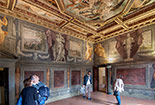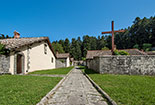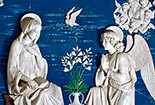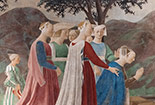Giorgio Vasari's works of art in Camaldoli
in Casentino, a Tuscan valley with which you can get familiar in every detail through this site
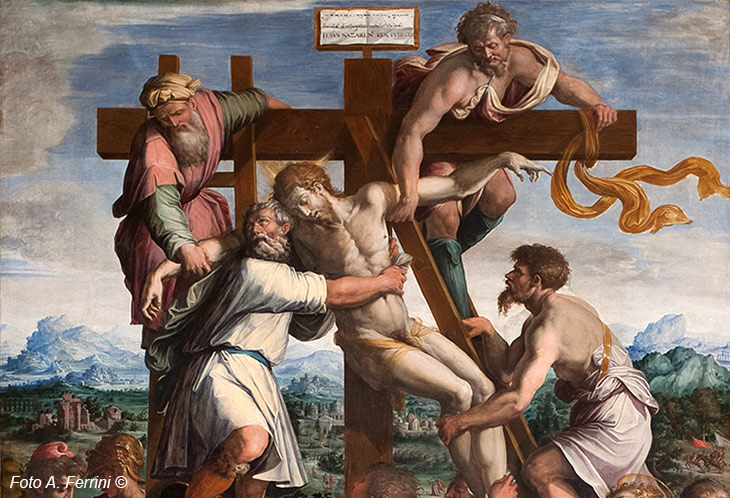
Texts and photos by Alessandro Ferrini ©
30 accurately described images of Giorgio Vasari works in Camaldoli. Clicca per ingrandire
A great figure of the Italian Renaissance, Giorgio Vasari
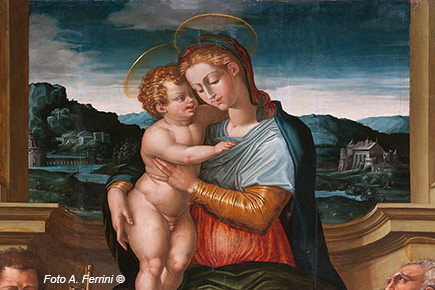 Giorgio Vasari was born in Arezzo on 30 July 1511 and died in Florence on 27 June 1574.
His family did not originate from Arezzo, but from Cortona. Nor was their surname Vasari, but Taldi. It was Giorgio's great-grandfather, Lazzaro, who moved to Arezzo. Then the grandfather, Giorgio also these, by profession as a potter, had his surname changed to Vasari. His father Antonio, a textile merchant, died in 1527 leaving his wife Maddalena Tacci and four children who had to face a period of misery. In this difficult moment, the family was helped by the Fraternity of the Laity of Arezzo to which the artist from Arezzo remained forever very grateful.
Giorgio Vasari was a great painter and architect, for these two artistic activities he is better known today, but at his time he acquired great notoriety as an art historian. Vasari was in fact the author of a treatise entitled "Lives of the most excellent Italian painters, sculptors and architects, from Cimabue to the present day", meaning our times are 1550, the year in which the treatise was published. The work, which saw an updated edition in 1568, is still today a point of reference for getting to know the approximately 150 painters, sculptors, architects covered here.
Giorgio Vasari began his artistic training as a child working in Arezzo in the workshop of the French painter Guglielmo di Marcillat, specialized in the decoration of stained glass windows, his are those of the Cathedral of Arezzo.
Still very young (it is said 13-14 years) Vasari moved to Florence, the cradle of the Italian Renaissance. Here he got to know and frequent Michelangelo, Andrea del Sarto and Baccio Bandinelli, great artists from whom Vasari learned the technique for the perspective composition in painting. Certainly of greater importance for the artistic training of the young Vasari was his subsequent frequentation in Arezzo with Giovan Battista di Jacomo, better known as "Rosso Fiorentino" and Francesco Salviati in Florence, both important exponents of "mannerism" of which the artist from Arezzo was known continuator.
Giorgio Vasari has also been defined as an "artist entrepreneur" for his ability to create knowledge and contacts with important and powerful Italian families. This will lead him to obtain commissions in many Italian cities such as Florence, Venice, Naples, Rome, Bologna. In this city there is one of his most valuable works: the "Dinner of San Gregorio", a table from 1540 preserved in the National Picture Gallery. Another famous painting by Vasari is the "Battle of San Vincenzo" where the Florentines defeat the Pisans, a fresco created in 1567 in the Salone del Cinquecento of Palazzo Vecchio in Florence.
Giorgio Vasari was born in Arezzo on 30 July 1511 and died in Florence on 27 June 1574.
His family did not originate from Arezzo, but from Cortona. Nor was their surname Vasari, but Taldi. It was Giorgio's great-grandfather, Lazzaro, who moved to Arezzo. Then the grandfather, Giorgio also these, by profession as a potter, had his surname changed to Vasari. His father Antonio, a textile merchant, died in 1527 leaving his wife Maddalena Tacci and four children who had to face a period of misery. In this difficult moment, the family was helped by the Fraternity of the Laity of Arezzo to which the artist from Arezzo remained forever very grateful.
Giorgio Vasari was a great painter and architect, for these two artistic activities he is better known today, but at his time he acquired great notoriety as an art historian. Vasari was in fact the author of a treatise entitled "Lives of the most excellent Italian painters, sculptors and architects, from Cimabue to the present day", meaning our times are 1550, the year in which the treatise was published. The work, which saw an updated edition in 1568, is still today a point of reference for getting to know the approximately 150 painters, sculptors, architects covered here.
Giorgio Vasari began his artistic training as a child working in Arezzo in the workshop of the French painter Guglielmo di Marcillat, specialized in the decoration of stained glass windows, his are those of the Cathedral of Arezzo.
Still very young (it is said 13-14 years) Vasari moved to Florence, the cradle of the Italian Renaissance. Here he got to know and frequent Michelangelo, Andrea del Sarto and Baccio Bandinelli, great artists from whom Vasari learned the technique for the perspective composition in painting. Certainly of greater importance for the artistic training of the young Vasari was his subsequent frequentation in Arezzo with Giovan Battista di Jacomo, better known as "Rosso Fiorentino" and Francesco Salviati in Florence, both important exponents of "mannerism" of which the artist from Arezzo was known continuator.
Giorgio Vasari has also been defined as an "artist entrepreneur" for his ability to create knowledge and contacts with important and powerful Italian families. This will lead him to obtain commissions in many Italian cities such as Florence, Venice, Naples, Rome, Bologna. In this city there is one of his most valuable works: the "Dinner of San Gregorio", a table from 1540 preserved in the National Picture Gallery. Another famous painting by Vasari is the "Battle of San Vincenzo" where the Florentines defeat the Pisans, a fresco created in 1567 in the Salone del Cinquecento of Palazzo Vecchio in Florence.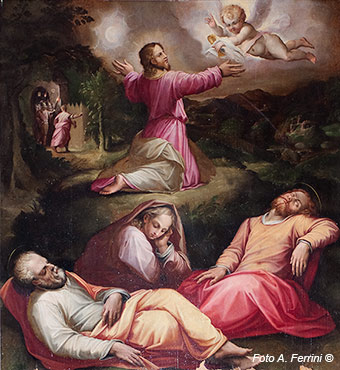 The best known person of power with whom Giorgio Vasari befriended and from whom he had many important work commissions was undoubtedly Cosimo I De 'Medici, Grand Duke of Tuscany. For this wealthy client Vasari developed his most important architectural projects, the most important of these will be the Uffizi complex in Florence in 1560, born as the seat of the administrative and judicial offices of the city. The "Vasari Corridor" dates back to 1565, a long, completely closed path built for safety reasons in just five months so that the Medici could move between the government rooms of Palazzo Signoria and their apartments in Palazzo Pitti, across the Arno, without go outside. From Cosimo I Giorgio Vasari had important architectural commissions also in "his" Arezzo. The best known is the construction of the large loggias, named after him, located in the highest part of the medieval Piazza Grande. Vasari's pictorial presence in Arezzo is also important and valuable. His large panels are present in the National Museum of Medieval and Modern Art, in the Church of the Badia and in that of the Santissima Annunziata. Those who want to enjoy his fresco paintings must instead visit what was his Arezzo residence, today the Casa Vasari State Museum which you can also see in detail whit this web section.
The Casentino, the first valley bathed by the Arno, can be honored to have several paintings by Giorgio Vasari which are preserved in the Monastery of Camaldoli. The artist began working for this sacred and important place in 1537, a difficult time from a professional point of view that had also made him slip into a sort of existential and spiritual crisis. The relationship with the monks, the contact with a wonderful nature and with the thousand colors of the Camaldolese forest, gave him a great hand to get out of this situation of crisis. This web section will show you all Vasari's works in Camaldoli and the places where they are located. The church is open to the public, the choir of the church and the Chapel of the Infirmary cannot be visited.
The best known person of power with whom Giorgio Vasari befriended and from whom he had many important work commissions was undoubtedly Cosimo I De 'Medici, Grand Duke of Tuscany. For this wealthy client Vasari developed his most important architectural projects, the most important of these will be the Uffizi complex in Florence in 1560, born as the seat of the administrative and judicial offices of the city. The "Vasari Corridor" dates back to 1565, a long, completely closed path built for safety reasons in just five months so that the Medici could move between the government rooms of Palazzo Signoria and their apartments in Palazzo Pitti, across the Arno, without go outside. From Cosimo I Giorgio Vasari had important architectural commissions also in "his" Arezzo. The best known is the construction of the large loggias, named after him, located in the highest part of the medieval Piazza Grande. Vasari's pictorial presence in Arezzo is also important and valuable. His large panels are present in the National Museum of Medieval and Modern Art, in the Church of the Badia and in that of the Santissima Annunziata. Those who want to enjoy his fresco paintings must instead visit what was his Arezzo residence, today the Casa Vasari State Museum which you can also see in detail whit this web section.
The Casentino, the first valley bathed by the Arno, can be honored to have several paintings by Giorgio Vasari which are preserved in the Monastery of Camaldoli. The artist began working for this sacred and important place in 1537, a difficult time from a professional point of view that had also made him slip into a sort of existential and spiritual crisis. The relationship with the monks, the contact with a wonderful nature and with the thousand colors of the Camaldolese forest, gave him a great hand to get out of this situation of crisis. This web section will show you all Vasari's works in Camaldoli and the places where they are located. The church is open to the public, the choir of the church and the Chapel of the Infirmary cannot be visited.



